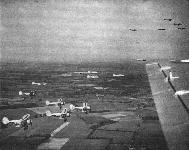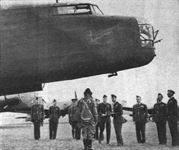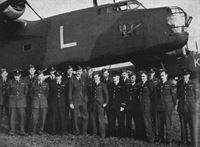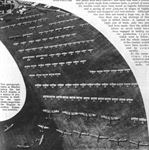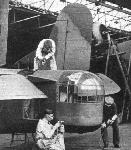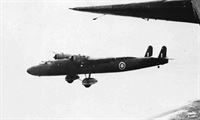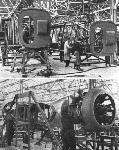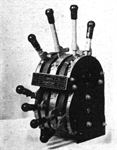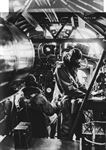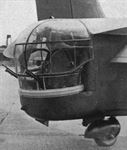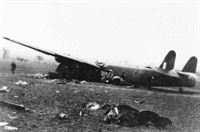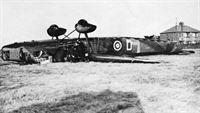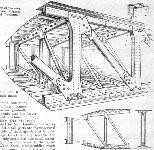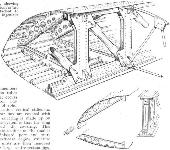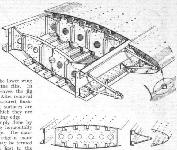
Описание
Страна : Великобритания
Год : 1936
Бомбардировщик или 20-местный транспортный самолет с экипажем из 4 или 5 человек
Harrow / H.P.54
Дальний бомбардировщик и военно-транспортный самолет. Двухмоторный цельнометаллический подкосный моноплан с двухкилевым оперением. Шасси неубирающееся, в обтекателях. Спроектирован в КБ фирмы "Хэндли-Пейдж" под руководством Г. Лачманна на базе опытного транспортного самолета НР.51. Опытного образца не было. Уже с июня 1936 г. завод "Хэйдли-Пейдж" в Криклвуде начал собирать серийные "Хэрроу" I (HP.54). Головной серийный самолет поднялся в воздух 10 октября. Всего изготовили 100 экз. (в т.ч. 38 экз. типа "Хэрроу" I).
Экипаж - 5 чел., 20 пассажиров. Моторы "Пегасус". Стрелковое вооружение в зависимости от модификации; на части самолетов полностью демонтировано. Бомбовая нагрузка до 910 кг.
Первые самолеты "Хэрроу" поступили в Королевские британские ВВС в январе 1937 г. Один самолет с лета 1940 г. до сентября 1941 г. состоял на вооружении в Канаде.
Серийно выпускались две модификации:
- "Хэрроу" I с моторами "Пегасус" X (шесть машин впоследствии переоснащены двигателями "Пегасус" XX), вооружение 4x7,9 (пулеметы "Виккерс" или "Льюис");
- "Хэрроу" II с моторами "Пегасус" XX, выпускался с июля 1937 г., вооружение 4x7,9 (пулеметы только типа "Виккерс").
Обе модификации во время войны переделывались - все вооружение снималось, а носовые и хвостовые стрелковые точки закрывались обтекателями. Этот вариант иногда именовался "Спэрроу".
Первоначально самолетами "Хэрроу" комплектовали бомбардировочные эскадрильи. По мере поступления более современных бомбардировщиков их с сентября 1939 г. передавали в транспортные части, которые начали эксплуатировать "Хэрроу" с мая 1940 г. В октябре того же года один самолет в порядке эксперимента оборудовали системой "Пандора" (LAM) для постановки парашютно-минных заграждений. Одна эскадрилья заградителей "Хэрроу" с декабря 1940 г. участвовала в отражении немецких ночных налетов на Англию. В июле 1941 г. "Хэрроу" в этом качестве заменили американские "бостоны".
Транспортные машины использовали для грузовых и пассажирских перевозок в метрополии, снабжения авиачастей на передовых аэродромах. С июня 1944 г. "Хэрроу" осуществляли перевозки для сил вторжения в Северной Франции. В сентябре того же года они подвозили оружие и боеприпасы десантникам под Арнемом, вывозя обратными рейсами раненых. Аэродром, на котором они базировались, в январе 1945 г. подвергся удару немецкой авиации, семь "Хэрроу" сгорели.
"Хэрроу" II сняли с производства в декабре 1937 г. В большинстве их списали к январю 1945 г., но последняя машина летала до апреля того же года.
"Хэрроу" II||
Размах:||26,9 м
Длина:||25,1 м
Моторы, количество х мощность:||2x925 л.с.
Взлетная масса, максимальная:||10500 кг
Максимальная скорость:||320 км/ч
Практический потолок:||7000 м
Дальность:||2000 км
Описание:
- Harrow / H.P.54
- Handley Page H.P.54 Harrow
- Flight, November 1936
AN EXPANSION BOMBER
Фотографии
-
Мировая Авиация 149
Регистрационный номер: K6994 Самолет K6994 эксплуатировался вначале в 420-м звене, участвовал в экспериментах с "авиационными минами" (операция "Mutton"). В декабре 1940 года 420-е звено было переименовано в 93-ю эскадрилью, а этот Harrow Mk II был передан в другую часть.
-
Flight 1937-05 / Flight
The completed Harrow. The engines are Bristol Pegasus. Note the pronounced taper of the wings.
-
Моделист-Конструктор Военно-транспортные самолеты Второй мировой войны
Первый серийный "Хэрроу", Рэдлетт (Англия), октябрь 1936 г. Носовая и кормовая турели отсутствуют, их проемы зашиты металлом
-
Aeroplane Monthly 1986-01 / A.Lumsden, T.Heffernan - Probe Probare (20)
Регистрационный номер: K6933 [12], G-AFRG [12] The prototype Harrow, K6933, pictured at Radlett. It first flew on October 10, 1936, the Air Ministry having ordered 100 Harrows in August the previous year.
-
Flight 1937-11 / Flight
ON HIS MAJESTY'S SERVICE: The Air Council's Airspeed Envoy, used by members of the Royal Family, framed by the forepart of a Handley Page Harrow heavy bomber.
Другие самолёты на фотографии: Airspeed Envoy / AS.6 - Великобритания - 1934
-
Flight 1936-11 / Flight
The Handley Page Harrow. The picture gives a good idea of the large size of this new heavy bomber and shows the positions of the central and rear gunners.
-
Flight 1938-05 / Flight
Handley Page Harrow bombers of No. 115 Squadron taxying in after a cross-country flight. The nose of a Battle gives a decorative touch.
Другие самолёты на фотографии: Fairey Battle - Великобритания - 1936
-
Aeroplane Monthly 1986-01 / A.Lumsden, T.Heffernan - Probe Probare (20)
Регистрационный номер: K6933 [12], G-AFRG [12] Cordes flying the prototype Harrow, K6933, first flown by him on October 10, 1936. This aircraft later became G-AFRG and was used for flight refuelling experiments in 1939. It was broken up after suffering damage during an air raid at Ford in August 1940.
-
Flight 1937-04 / Flight Advertisements
Регистрационный номер: K6933 [12], G-AFRG [12] HANDLEY-PAGE "HARROW" Two 850 h.p. Bristol "Pegasus" engines
-
Jane's All the World Aircraft 1938 / 03 - All the world's aeroplanes
Серийный "Хэрроу" I в полете
The Handley Page "Harrow" Heavy Bomber (two Bristol "Pegasus" engines). -
Aeroplane Monthly 1994-03 / J.Maynard - Pickard, hero of Amiens (1)
Регистрационный номер: K6988 [2] Harrow II K6988 of 214 Sqn airborne from RAF Felt well - Pickard’s aircraft was K6993. K6988 later passed to 271 Sqn and was struck off RAF charge in December 1940.
-
Aeroplane Monthly 1985-01 / L.Coombs - The expanding years 1936-1939 (3)
Регистрационный номер: K6988 [2] Handley Page Harrow I K6988 of 214 Squadron photographed in 1938. The Harrow was one of the earliest of the RAF’s monoplane bombers but was never used operationally in the bomber role.
-
Flight 1937-06 / Flight
Регистрационный номер: K6933 [12], G-AFRG [12] The Handley Page Harrow is in the same category as A.W. Whitley and mounts a pair of Bristol Pegasus engines.
-
Flight 1938-05 / Flight
HANDLEY PAGE HARROW II: Bomber (Two Pegasus XX engines - 925 h.p. each at 10,000ft.); span, 88ft. 5in.; gross weight, 23,500 lb.; max. speed, 200 m.p.h. at 10,000ft.
-
Flight 1937-04 / Flight
Регистрационный номер: K6947 [3] Harrow K6947 photographed at Radlett during a test flight before delivery to 37 Squadron early in 1937.
HEAVYWEIGHT HEAD-ON: A Handley Page Harrow heavy bomber on test prior to delivery to an R.A.F. unit. The Harrow is being produced for the Air Ministry in two forms: the Harrow Mk. I has moderately supercharged Pegasus Xs (850 h.p. at 4,000 ft.) and the Mk. II mounts Pegasus XXs, which are fully supercharged and give 820 h.p. at 9,000 ft. Nose, midships and tail gun positions are incorporated and Handley Page slots and slotted flaps confer a wide speed range. Alternatively to its bombing activities the Harrow may be used as a troop transport. -
Flight 1937-05 / Flight
Регистрационный номер: K6947 [3] -
Flight 1937-04 / Flight
A SHADY CUSTOMER: "Shadow shading" is the Air Ministry's term for the new system of camouflage, here seen applied to a Handley Page Harrow.
-
Flight 1937-10 / Flight
Going on parade: A Flight photograph taken from one of the units of a Squadron of Harrows on the way to Mildenhall.
-
Flight 1937-06 / Flight
SKY PARADE: Gauntlets, Ansons and Harrows in a "skeleton flight" rehearsal for the massed fly-past which will feature in the RA.F. Display to be held at Hendon on June 26. It is to be hoped that the squadrons will fly at closer intervals and at a lower altitude than did those in the so-called fly-past of two years ago.
Другие самолёты на фотографии: Avro Anson / Type 652 - Великобритания - 1935Gloster Gauntlet - Великобритания - 1929
-
Flight 1938-03 / Flight
No. 214 (B.) Squadron’s H.P. Harrows demonstrate echelon, stepped up - an unusual formation for heavy bombers.
-
Flight 1939-05 / Flight
Handley Page Harrows, of the type shown in formation in the Flight photograph, were the first large monoplane bombers to go into service with the R.A.F.
-
Aeroplane Monthly 1984-12 / L.Coombs - The expanding years 1936-1939 (2)
Harrows ot No. 214 (B.) Squadron take off in formation from the smooth turf of Feltwell in February 1938.
-
Aeroplane Monthly 1988-08 / Personal album. Military
This 214 Sqn Handley Page Harrow II heavy bomber is seen during a visit to RAF Kenley in April 1939 of tier a flight from Feltwell. A number of 615 Sqn personnel at Kenley subsequently had a trip in the Harrow. The type served with 214 Sqn from January 1937 until 1939, when it was succeeded by the Wellington.
-
Jane's All the World Aircraft 1938 / 02 - The progress of the world in military aviation during the year 1937-38
Регистрационный номер: K6947 [3] A Handley Page "Harrow" Long-Range Bomber (two Bristol "Pegasus").
-
Flight 1938-05 / Flight
Регистрационный номер: K6993 [2] Line-up of 214 Squadron Harrows photographed early in 1938 at RAF Feltwell.
Handley Page Harrow long-range bombers, showing the installation of the Nash and Thompson power-driven turret in the nose. -
Flight 1938-10 / Flight
Регистрационный номер: K6993 [2] The Handley Page Hampden (two Bristol Pegasus) follows the Harrow (shown) as the standard production type at the Handley Page works;
-
Flight 1938-05 / Flight
The King inspects machines of the Bomber Group. Above him towers the nose of a Harrow, and behind can be distinguished a Whitley, Wellesley and Blenheim.
Другие самолёты на фотографии: Armstrong Whitworth Whitley / A.W.38 - Великобритания - 1936Bristol Blenheim - Великобритания - 1936Vickers Wellesley - Великобритания - 1935
-
Flight 1938-03 / Flight
Some pilots of No. 214 (Bomber) Squadron (left to right): P/O. J. B. Murray; Sgt. Sach; P/O. F. L. H. Eddison; Sgt. Styles; P/O. C. L. Gilbert; P/O. K. W. Kaufmann; P/O. H. W. Poultney; Sqn Ldr. H. A. Constantine; P/O. P. C. Pickard; P/O. J. M. Griffith-Jones; P/O. E. J. Carter; F/O. R. E. Dupont; P/O. H. E. Bufton; P/O. L. M. Craigie- Halkett; F/O. B. D. Sellick; P/O. R. C. Simmons; Flt. sgt. Blake: Sgt. Duffy.
-
Flight 1937-06 / Flight
Typical aerodrome scene indicative of the colourful spectacles to be seen all over the country on Saturday, here, with a Harrow in prominence, at Biggin Hill.
-
Aeroplane Monthly 1994-03 / J.Maynard - Pickard, hero of Amiens (1)
A dozen 214 Sqn Harrow IIs at RAF Feltwell in May 1938. The squadron received its Harrows from January 1937, retaining them until July 1939, by which time the Wellington I had been taken on strength.
-
Flight 1938-06 / Flight
HARROWS EN MASSE: An impressive scene at Feltwell, Norfolk.
-
Flight 1938-04 / Flight
This photograph, taken at Hendon before the last R.A.F. display, is a history of production in itself, for the types shown range from the Virginia to modern Expansion bombers.
Другие самолёты на фотографии: Bristol Blenheim - Великобритания - 1936Vickers Virginia - Великобритания - 1922Vickers Wellesley - Великобритания - 1935
-
Aeroplane Monthly 1986-01 / A.Lumsden, T.Heffernan - Probe Probare (20)
Handley Page test pilot the late J.L.Cordes, complete with monocle, photographed with the prototype Harrow.
-
Flight 1937-06 / Flight
The Flight photograph shows the stern defence (conceived by the Nash and Thompson) of a Harrow.
-
Flight 1937-05 / Flight
CHIAROSCURISTS WITH COLOUR: “Shadow shading” a Harrow before delivery to a squadron, following an Air Ministry decision in early 1937 to camouflage all medium and heavy bombers.
-
Flight 1937-03 / Flight
LEG SHOW: Members of the R.A.F. Staff College, Andover, in the undercarriage-erection department of Handley Page's Cricklewood works, where they inspected the methods used for the rapid production of large numbers of Harrow heavy bombers.
-
Aviation Historian 25 / B.Gardner - Fill 'er up!
Регистрационный номер: G-AFRG [12], K6933 [12] Anchors aweigh! Harrow G-AFRG minus its outer wings and tail aboard the SS Beaverford bound for Newfoundland in April 1939;
-
Aviation Historian 25 / B.Gardner - Fill 'er up!
Регистрационный номер: G-AFRG [12], K6933 [12] Hugh Johnson building part of the ramp to get the aircraft off the scow and up the mole to the airfield at Longueuil;
-
Aviation Historian 25 / B.Gardner - Fill 'er up!
Регистрационный номер: G-AFRG [12], K6933 [12] The Harrow towers above the crew at the top of the ramp track;
-
Aviation Historian 25 / B.Gardner - Fill 'er up!
Регистрационный номер: G-AFRG [12], K6933 [12] The Harrow’s port mainwheel tyre pinches against the side of the ramp track, showing how little room for error there was. Adding to the crew’s headaches was the need to find suitable timber with which to make the tracks.
-
Aviation Historian 25 / B.Gardner - Fill 'er up!
Регистрационный номер: G-AFRG [12], K6933 [12] Flight Refuelling’s Harrow G-AFRG after assembly at Fairchild’s airfield and factory at Longueuil, near Montreal, in May 1939. Large observation transparencies were incorporated into the Harrows’ forward fuselages’ fabric covering to give the operators the field of vision required to undertake the inflight refuelling operation.
-
Flight 1939-08 / Flight
Регистрационный номер: G-AFRG [12], K6933 [12] NEW OVERLOAD: Two Harrow bombers, one outside and the other inside the hangar, which are used at Haltie’s Camp, Newfoundland, for the air refuelling of the Short boats used on the British Atlantic mail service. Only one is actually needed, but the second has been shipped over for use in case of emergency or minor accident. For Caribou's initial return crossing the refuelling equipment was not used, as a following wind and good conditions meant that the machine would reach not only Foynes, but also Southampton, without the necessity for topping up.
-
Flight 1939-05 / Flight
Sir Alan Cobham, managing director of Flight Refuelling, Ltd., in the pilot’s cockpit of the Harrow which is used as a tanker.
-
Flight 1939-05 / Flight
The nozzle of the hose pipe is shaped to fit the cone in the receiving aircraft, where it is held fast by hydraulically-operated toggles.
-
Aviation Historian 25 / B.Gardner - Fill 'er up!
The fuel-hose twin-reel arrangement in the forward fuselage of one of the Harrows, operated by the larger winch mechanism pictured right (a smaller winch was used forward of the main winch to play out and withdraw the hauling-line cable);
-
Flight 1939-05 / Flight
The hand-operated winch used for bringing the hauling cable on board the tanker.
-
Aeroplane Monthly 1989-01 / A.Lumsden, T.Heffernan - Per Mare Probare (13)
Looking more like a scene from a Korda film epic, this photograph shows the Harrow's hauling-down windlass being operated in September 1939.
-
Aviation Historian 25 / B.Gardner - Fill 'er up!
The fuel-hose winch bolted to the floor of the Harrows. Marcus Langley, FRL's technical manager, also considered the use of the de Havilland Albatross as a tanker, although whether it would have had sufficient structural integrity to accomodate the equipment required is open to speculation.
-
Aviation Historian 25 / B.Gardner - Fill 'er up!
The Birmingham Small Arms Co (BSA) supplied a gun capable of firing a 15in (38cm) steel rod with a grapnel on the end, which would take 300ft (90m) of 5cwt steel cable with it;
-
Aviation Historian 25 / B.Gardner - Fill 'er up!
Регистрационный номер: G-AFRG [12], K6933 [12] With the legend "REFUELLING" emblazoned in large white letters across the top surface of its wing so as to avoid any confusion about its purpose, Harrow G-AFRG heads out over Newfoundland for another sortie. An average refuelling sortie would take around 15min to complete and would involve the transfer of some 850-950gal.
-
Aeroplane Monthly 1989-01 / A.Lumsden, T.Heffernan - Per Mare Probare (13)
Регистрационный номер: K7029 [2], G-AFRH [2] Close-up of the Harrow tanker, showing the fuel hose trailing from the forward fuselage. K7029 later became G-AFRH and, following impressment with the RCAF, was cannibalised. Powered by two 925 h.p. Bristol Pegasus XXs, the Harrow II cruised at about 160 m.p.h.
-
Aviation Historian 25 / B.Gardner - Fill 'er up!
Регистрационный номер: G-AFRL [13] Harrow G-AFRL trails its hose during a refuelling exercise in the UK in the summer of 1939. By the time the 16 experimental transatlantic airmail flights had been completed at the end of September 1939, Cabot and Caribou had transported a total of around 13,000lb (6,000kg) of freight and mail.
-
Flight 1939-05 / Flight
Регистрационный номер: G-AFRL [13] REFUELLING TESTS: An Armstrong Whitworth A.W.23, acting as the “receiver,” taking on fuel from a Handley Page Harrow, used as the “tanker.” The hose pipe passes from the forward part of the tanker to the stern of the aircraft to be fuelled. Our photograph was taken from the latter machine.
Другие самолёты на фотографии: Armstrong Whitworth A.W.23 - Великобритания - 1935
-
Flight 1939-11 / Flight
The “Harrow” tanker as it appears from the aircraft being refuelled.
-
Flight 1939-05 / Flight
Регистрационный номер: G-AFRL [13] From Harrow A.W. XXIII: combination of views gives a good idea of fuelling in the air. The nozzle of the hose pipe is nearing the cone in the tail of the A.W., drawn by the cable, which is shown slightly thickened to make it discernible. By no means the whole length of hose had been reeled off when the picture was taken.
Другие самолёты на фотографии: Armstrong Whitworth A.W.23 - Великобритания - 1935
-
Aeroplane Monthly 1989-01 / A.Lumsden, T.Heffernan - Per Mare Probare (13)
The tanker, having picked up the wire trailing behind Cabot, climbs above and to one side of the boat's tail.
Другие самолёты на фотографии: Short Empire / S.23 - Великобритания - 1936
-
Aeroplane Monthly 1989-01 / A.Lumsden, T.Heffernan - Per Mare Probare (13)
Hooked up and ready to transfer fuel.
Другие самолёты на фотографии: Short Empire / S.23 - Великобритания - 1936
-
Aeroplane Monthly 1977-01 / M.Langley - Fifty years in aviation
Регистрационный номер: G-AFRL [13] Handley Page Harrow G-AFRL and Short S.30 G-AFCU Cabot demonstrate flight refuelling over Southampton.
Другие самолёты на фотографии: Short Empire / S.23 - Великобритания - 1936
-
Air International 1987-03 / R.Braybrook - The Sixties, the Thirties and the American Challenge
Регистрационный номер: G-AFRL [13] Attempting to catch up with the Americans, Britain developed the Short C-Class flying boats, but had to resort to air-to-air refuelling to achieve non-stop flights from Eire to Newfoundland.
Другие самолёты на фотографии: Short Empire / S.23 - Великобритания - 1936
-
Aviation Historian 25 / B.Gardner - Fill 'er up!
Регистрационный номер: G-AFRL [13] Steady as she goes - Harrow G-AFRL remained in the UK and undertook further development trials with Short S.30 G-AFCU Cabot during June-July 1939. Flight Refuelling issued a guarantee of "service in any part of the world to deliver 1,000gal of fuel in 10min, at speeds with existing equipment ranging from 110 to 125 m.p.h."
Другие самолёты на фотографии: Short Empire / S.23 - Великобритания - 1936
-
Aeroplane Monthly 1974-05 / P.Moss - Wings for the Empire (5)
Регистрационный номер: G-AFRL [13] In-flight refuelling with Handley Page Harrow G-AFRL and Short S.30 G-AFCU Cabot, 1939.
Другие самолёты на фотографии: Short Empire / S.23 - Великобритания - 1936
-
Flight 1939-08 / Flight
Регистрационный номер: G-AFRL [13] В июле 1939 года, еще до начала полетов между Саутгемптоном и Монреалем, в районе Саутгемптона отрабатывались дозаправки от самолета Handley Page Harrow.
PREPARING FOR THE FIRST: A photograph taken last week at Southampton showing Cabot receiving fuel from a Harrow tanker. Last week-end saw Caribou, commanded by Capt. J. C. Kelly Rogers, with Capt. S. G. Long as chief officer and Mr. B. C. Frost as first officer, make her first regular Atlantic crossing after being refuelled at Foynes. The machine, carrying 1,055 lb. of mail, reached Newfoundland at 10.10 p.m. (G.M.T.) on Saturday and was due to leave New York, on the return flight, yesterday. Cabot will make the next eastward crossing on Saturday.Другие самолёты на фотографии: Short Empire / S.23 - Великобритания - 1936
-
Aeroplane Monthly 1989-01 / A.Lumsden, T.Heffernan - Per Mare Probare (13)
Регистрационный номер: G-AFRL [13] Another view of Cabot and Harrow G-AFRL over Southampton in July 1939. The time taken to transfer 900gal was about 15min.
Другие самолёты на фотографии: Short Empire / S.23 - Великобритания - 1936
-
Air International 1995-11 / D.Allport - History of In-Flight Refuelling
Регистрационный номер: G-AFRL [13] Flight Refuelling Ltd's appropriately registered HP.54 Harrow I tanker G-AFRL refuels Imperial Airways Short S.30 Empire 'C' Class flying-boat G-AFCU/Cabot over Southampton Water circa 1939 using the looped hose method.
Другие самолёты на фотографии: Short Empire / S.23 - Великобритания - 1936
-
Aviation Historian 25 / B.Gardner - Fill 'er up!
Регистрационный номер: G-AFRL [13] Handley Page Harrow tanker G-AFRL feeds Short S.30 G-AFCU Cabot with fuel over the South Coast during trials in the summer of 1939. The “Ejector” method of contact developed by Flight Refuelling was sometimes referred to as “cow and calf”, whereby the tanker was the cow and the receiver the calf
Другие самолёты на фотографии: Short Empire / S.23 - Великобритания - 1936
-
Aeroplane Monthly 1989-01 / A.Lumsden, T.Heffernan - Per Mare Probare (13)
Регистрационный номер: G-AFRL [13] Cabot has just taken aboard 940gal of fuel from Harrow tanker G-AFRL over Southampton on July 30, 1939.
Другие самолёты на фотографии: Short Empire / S.23 - Великобритания - 1936
-
Flight 1939-05 / Flight
Регистрационный номер: G-AFRL [13] Sequence of making contact: In the upper picture the tanker’s grapnel has caught the hauling line of the receiving aircraft. In the middle photograph the weighted grapnel on the end of the hauling line has nearly reached the winch in the tanker. In the lower picture the end of the hauling line has been attached to the nozzle of the hose, which is, beginning to emerge from the reel on the tanker. The cable is shown slightly thicker to make it discernible.
-
Aviation Historian 25 / B.Gardner - Fill 'er up!
Регистрационный номер: G-AFRG [12], K6933 [12] After trouble with the Harrows’ wheel fairings digging into the snow, the latter were removed, as seen in this photograph of G-AFRG flying past the hangar at Gander on a snowy day in late 1939. This machine became “794” in RCAF service and operated with the Test & Development Establishment at Rockcliffe, Ontario, until November 1941, when it was struck off charge.
-
Aviation Historian 25 / B.Gardner - Fill 'er up!
One of the two Harrows at Gander was fitted with a ski tailskid for taxying experiments on the snow. Much of the information gained from the Harrows’ trials proved useful for subsequent operations from the airfield, which was used extensively by the RAF and USAAF as a stop for aircraft being ferried to Europe throughout the war.
-
Aviation Historian 25 / B.Gardner - Fill 'er up!
Регистрационный номер: G-AFRH [2], K7029 [2] Following the completion of the transatlantic airmail experiment, Harrows G-AFRG and ’FRH remained at Gander to continue inflight refuelling trials in order to keep the crews current in case the service was resumed. With its refuelling equipment still fitted, 'FRH is seen here in October 1939, during which a dozen practice flights were completed.
-
Моделист-Конструктор Военно-транспортные самолеты Второй мировой войны
"Спэрроу", использовавшийся во время войны в качестве военно-транспортного самолета
-
Flight 1937-05 / Flight
Left, centre section in its jig. On the right, the three main portions of a wing being assembled.
-
Flight 1937-05 / Flight
The bomb cage (right) is built as a complete unit in a swivelling jig. On the left, outer wing portion units. Note that the skin covering already has its proper camber.
-
Flight 1937-05 / Flight
The fuselage, although of girder construction, is also built in several units. The upper picture shows two, with their front gun turrets carried on metal-covered structures. On the lower picture is the mounting and cowling of one of the Bristol Pegasus engines on the wing leading edge.
-
Flight 1937-12 / Flight
The complete power plant - two Pegasus radials - of a Handley Page Harrow heavy bomber on its way to be fitted. Standardisation of complete units is becoming more important, particularly for military purposes.
-
Flight 1937-08 / Flight
A BOMBER'S BRIDGE: The pilot's cockpit of a Handley Page Harrow Mk. II heavy bomber, showing the location of the flying controls, including the long operating lever for the Dowty flap gear, and the Hobson mixture and throttle controls associated with the twin Pegasus XX fully supercharged radials.
-
Flight 1939-12 / Flight
EIGHT IN HAND: The Bloctube engine control unit as fitted to the Handley Page Harrow. It provides throttle, mixture, D. H. airscrew-pitch, air intake and oil-cooler control for each of the two Bristol Pegasus engines (with Hobson carburettors). The makers are R.T. Bloctube Controls, Cricklewood Broadway Works, 25, Sheldon Road, London, N.W.2.
-
Flight 1938-03 / Flight
A vivid impression, by Flight's photographer, of the crew of one of the Handley Page Harrow heavy bombers of No. 214 (Bomber) Squadron. The second pilot has left his seat to check navigation at the chart table; the head of the first pilot can just be seen above the fuselage cross-member. Seated on the left is the radio operator.
-
Aeroplane Monthly 1988-08 / Personal album. Military
View of South Croydon as seen from the tail turret of the 214 Sqn Harrow II that visited RAF Kenley in April 1939. In addition to the 0-303in Browning guns mounted in the tail, dorsal and nose power-operated turrets, the Harrow carried a bomb load of 3,000 lb. On the outbreak of war the type was operated on transport duties, carrying 20 men.
-
Flight 1940-02 / Flight
The next stage in the development of the Nash and Thompson power-driven gun turret can be seen in this picture of the tail of a Handley Page Harrow.
-
Aeroplane Monthly 1989-01 / Personal album. Military
Регистрационный номер: K7017 The two photographs depict Handley Page Harrow II K7017 of 37 Sqn, based at RAF Feltwell in Norfolk. One of a batch of 62 Harrows delivered to the RAF between July and December 1937, K7017 is seen following an overshoot at RAF Hendon on July 23, 1938 at a spot not far from the location of the present RAF Museum.
-
Flight 1937-07 / Flight
Inspired by the spectacle of a "next war" air battle at the R.A.F. Display - an impression, specially drawn for Flight by F. Gordon-Crosby, of Handley Page Harrow heavy bombers, flying high over enemy territory, being attacked by hostile fighters. The interceptors are seen diving with a view to zooming from beneath. But with fifty guns to a squadron the Harrows are by no means "cold meat" for a defensive force.
-
Aeroplane Monthly 1986-12
First flight of the Handley Page Harrow, October 10, 1936
-
Flight 1937-05 / Flight
Details of the construction of the wing centre section. The lower diagram shows the constructional ''scheme.''
-
Flight 1937-05 / Flight
Details of outer wing portion, showing how sheet-metal nose covering is built as two complete units, afterwards attached to single girder spar. Note the ingenious leading edge joint.
-
Flight 1937-05 / Flight
The ingenious tail construction. Top and bottom coverings are first attached to the tailplane ribs; then the "box" is completed by riveting-on the front and rear channels, and finally the leading edge unit is attached.
-
Aviation Historian 25 / B.Gardner - Fill 'er up!
Hauling-line from AW.23 snags wingtip-hook of Harrow; hook (attached to contact-line running beneath wing to Harrow cabin), sinker-weight and hauling-line drop free, to be hauled aboard Harrow; refuelling line attached to hauling-line and winched back to AW.23, which refuels and disconnects refuelling line when full; refuelling line hauled back aboard Harrow
Другие самолёты на фотографии: Armstrong Whitworth A.W.23 - Великобритания - 1935
-
Aviation Historian 25 / B.Gardner - Fill 'er up!
THE “EJECTOR” OR “LOOPED-HOSE” METHOD. Illustrated here is the sequence of operations for the “Ejector” or “Looped-Hose” method of refuelling in flight, developed by Flight Refuelling Ltd during 1939-40.
Другие самолёты на фотографии: Short Empire / S.23 - Великобритания - 1936
-
Моделист-Конструктор Военно-транспортные самолеты Второй мировой войны
Handley Page Harrow I
- Фотографии



















